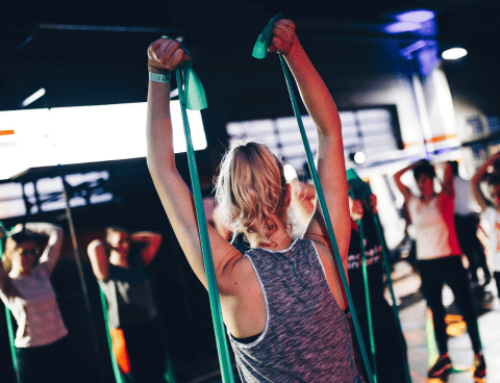CrossFit Workout Routine: 4 Hacks for Athletes
CrossFit has done great things for the world of health and fitness. However, a regular CrossFit workout routine can often be a fairly haphazard affair in terms of progression and programming. It lacks the necessary levels of specificity to make it a great fit for a competitive sports.
With that in mind, let’s take a look at how we can hack CrossFit to promote better sports performance.
Hack 1: Keep a Strength Focus
In the words of legendary strength coach Mark Rippetoe, “Strength is the most general of all athletic adaptations. All other physical capacities, such as power (a guy with a 400-pound Deadlift cleans more than a guy with a 150-pound Deadlift), balance and coordination, depend on force production within the physical environment. If strength improves, all other capacities improve with it, to varying degrees.” Or to put it another way, all other things being equal, the strongest athlete always wins.
All sports depend on the ability to produce force. For example, if you do not possess great relative body strength, you will never be able to run fast. This is due to the fact that all aspects of proper running technique require high levels of muscular strength. If you can’t achieve proper knee drive, arm swing, posture and push-off, you can’t be fast.
Make sure to include at least three strength sessions a week before met-con/skill work. Use big compound movements (if you’re thinking Squat, Deadlift, Bench Press, Overhead Press and Chin-Ups, give yourself a pat on the back) and get really good at them.
As a competitive athlete engaged in a whole load of other exercise and skills practice, you may find it helpful to employ a slightly lower volume than traditional strength training programs, or periodize the volume in four-week cycles to allow for recovery (Wendler’s 5/3/1 or Eric Cressey’s programs are great examples of this approach).
Hack 2: Appropriate Met-Con
The specificity principle essentially states that you become good at what you do repeatedly.
Traditional CrossFit met-cons are a great way to improve your work capacity and relative strength through improved body composition, but they are often fairly long stints of high-intensity work with little or no rest. Yet even in a running-centric sport like soccer, intense bursts of sprinting are usually pretty short and interspersed with longer intervals at a lower intensity.
Rest intervals should mimic the nature of your sport. If you’re a soccer player, you might pair 20- to 30-second intervals of intense effort with two minutes of medium or low-intensity exercise for a number of rounds. If you’re a boxer, assuming three-minute rounds, it makes sense to do met-cons in sets of three minutes with a minute or so of rest, or three-minute AMRAPS.
RELATED: Is CrossFit a Good Fit for Baseball Players?
Hack 3: Planned Progression and Periodization
One of CrossFit’s biggest weaknesses is that it doesn’t employ proper periodization to allow fatigue to dissipate and show gains. Nor does it make the most of progressive overload. Progressive overload is probably the most important principle in strength training; it simply means doing more over time.
How do you make the most of progressive overload? The simplest way to progressively overload is to add more weight to the bar. This is known as increasing training intensity. However, you can also increase training volume (doing more sets or reps) or increase training density (doing the same weight, sets and reps in less time or doing more weight, sets and/or reps in the same time.)
Hack 4: Power Work as Power Work
CrossFit often employs things like Olympic lifts, Med Ball Throws and Box Jumps in its programming. These are great power exercises, no doubt, but in CrossFit they are often done with high reps and/or limited rest periods. In order to properly develop power and rate-of-force production, the nervous system must be able to work at full capacity. It must be fully refreshed and recovered. Sprinting, jumping, throwing, etc., need to be done at low reps and with full recovery if you hope to be an explosive athlete.
Sample Workout
This puts it all together for a typical team sport athlete in a four-day training split.
Day 1
- A: Box Jumps – 3×5
- B: Trap Bar Deadlift – 5/3/1* (*sets and reps a prescribed in Jim Wendler’s 5/3/1)
- C1: Pallof Press – 3×8
- C2: Reverse Lunge – 3×8/side
- Met-con – 3-minute AMRAP of Sandbag Clean and Press
Day 2
- A. Med-Ball Rotational Throw – 2×10 (light med ball thrown for max. speed)
- B1. Neutral Grip Dumbbell Push Press – 4×6
- B2. Weighted Chin-Up – 4×6
- C. Banded No-Monies – 3×12
- Met-con – Push-Up and Inverted Row Circuit, 30 seconds work with 60 seconds rest; repeat 6 to 12 times depending on fitness level.
Day 3
- A. Lateral Jumps (a.k.a. Heidens) – 3×5/side
- B. Back Squat – 5/3/1*
- C. Dead-Bugs – 3×6/side
- Met-con – 40-meter Hill Sprints with 60-second Plank hold as active recovery; repeat 6 to 12 times depending on fitness level.
Day 4
- Med-Ball Squat to Throw – 5×1 (heavy med ball thrown for max. distance)
- B1. Close Grip Bench Press – 5/3/1*
- B2. Wide-Grip Seated Cable Row – 4×6
- C1. Half-Kneeling Single-Arm Overhead Press – 3×8
- C2. Prone Single-Arm Y-Raise – 3×12/side
- Met-Con – 4-minute Farmer’s Walk for max. distance (use heavy dumbbells or a loaded trap bar and rest as needed.)
RELATED: The Welcome Mat: 7 Tips to Getting Started Right in CrossFit
RECOMMENDED FOR YOU
MOST POPULAR
CrossFit Workout Routine: 4 Hacks for Athletes
CrossFit has done great things for the world of health and fitness. However, a regular CrossFit workout routine can often be a fairly haphazard affair in terms of progression and programming. It lacks the necessary levels of specificity to make it a great fit for a competitive sports.
With that in mind, let’s take a look at how we can hack CrossFit to promote better sports performance.
Hack 1: Keep a Strength Focus
In the words of legendary strength coach Mark Rippetoe, “Strength is the most general of all athletic adaptations. All other physical capacities, such as power (a guy with a 400-pound Deadlift cleans more than a guy with a 150-pound Deadlift), balance and coordination, depend on force production within the physical environment. If strength improves, all other capacities improve with it, to varying degrees.” Or to put it another way, all other things being equal, the strongest athlete always wins.
All sports depend on the ability to produce force. For example, if you do not possess great relative body strength, you will never be able to run fast. This is due to the fact that all aspects of proper running technique require high levels of muscular strength. If you can’t achieve proper knee drive, arm swing, posture and push-off, you can’t be fast.
Make sure to include at least three strength sessions a week before met-con/skill work. Use big compound movements (if you’re thinking Squat, Deadlift, Bench Press, Overhead Press and Chin-Ups, give yourself a pat on the back) and get really good at them.
As a competitive athlete engaged in a whole load of other exercise and skills practice, you may find it helpful to employ a slightly lower volume than traditional strength training programs, or periodize the volume in four-week cycles to allow for recovery (Wendler’s 5/3/1 or Eric Cressey’s programs are great examples of this approach).
Hack 2: Appropriate Met-Con
The specificity principle essentially states that you become good at what you do repeatedly.
Traditional CrossFit met-cons are a great way to improve your work capacity and relative strength through improved body composition, but they are often fairly long stints of high-intensity work with little or no rest. Yet even in a running-centric sport like soccer, intense bursts of sprinting are usually pretty short and interspersed with longer intervals at a lower intensity.
Rest intervals should mimic the nature of your sport. If you’re a soccer player, you might pair 20- to 30-second intervals of intense effort with two minutes of medium or low-intensity exercise for a number of rounds. If you’re a boxer, assuming three-minute rounds, it makes sense to do met-cons in sets of three minutes with a minute or so of rest, or three-minute AMRAPS.
RELATED: Is CrossFit a Good Fit for Baseball Players?
Hack 3: Planned Progression and Periodization
One of CrossFit’s biggest weaknesses is that it doesn’t employ proper periodization to allow fatigue to dissipate and show gains. Nor does it make the most of progressive overload. Progressive overload is probably the most important principle in strength training; it simply means doing more over time.
How do you make the most of progressive overload? The simplest way to progressively overload is to add more weight to the bar. This is known as increasing training intensity. However, you can also increase training volume (doing more sets or reps) or increase training density (doing the same weight, sets and reps in less time or doing more weight, sets and/or reps in the same time.)
Hack 4: Power Work as Power Work
CrossFit often employs things like Olympic lifts, Med Ball Throws and Box Jumps in its programming. These are great power exercises, no doubt, but in CrossFit they are often done with high reps and/or limited rest periods. In order to properly develop power and rate-of-force production, the nervous system must be able to work at full capacity. It must be fully refreshed and recovered. Sprinting, jumping, throwing, etc., need to be done at low reps and with full recovery if you hope to be an explosive athlete.
Sample Workout
This puts it all together for a typical team sport athlete in a four-day training split.
Day 1
- A: Box Jumps – 3×5
- B: Trap Bar Deadlift – 5/3/1* (*sets and reps a prescribed in Jim Wendler’s 5/3/1)
- C1: Pallof Press – 3×8
- C2: Reverse Lunge – 3×8/side
- Met-con – 3-minute AMRAP of Sandbag Clean and Press
Day 2
- A. Med-Ball Rotational Throw – 2×10 (light med ball thrown for max. speed)
- B1. Neutral Grip Dumbbell Push Press – 4×6
- B2. Weighted Chin-Up – 4×6
- C. Banded No-Monies – 3×12
- Met-con – Push-Up and Inverted Row Circuit, 30 seconds work with 60 seconds rest; repeat 6 to 12 times depending on fitness level.
Day 3
- A. Lateral Jumps (a.k.a. Heidens) – 3×5/side
- B. Back Squat – 5/3/1*
- C. Dead-Bugs – 3×6/side
- Met-con – 40-meter Hill Sprints with 60-second Plank hold as active recovery; repeat 6 to 12 times depending on fitness level.
Day 4
- Med-Ball Squat to Throw – 5×1 (heavy med ball thrown for max. distance)
- B1. Close Grip Bench Press – 5/3/1*
- B2. Wide-Grip Seated Cable Row – 4×6
- C1. Half-Kneeling Single-Arm Overhead Press – 3×8
- C2. Prone Single-Arm Y-Raise – 3×12/side
- Met-Con – 4-minute Farmer’s Walk for max. distance (use heavy dumbbells or a loaded trap bar and rest as needed.)
RELATED: The Welcome Mat: 7 Tips to Getting Started Right in CrossFit
[cf]skyword_tracking_tag[/cf]










